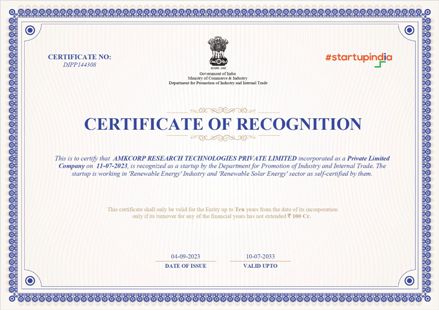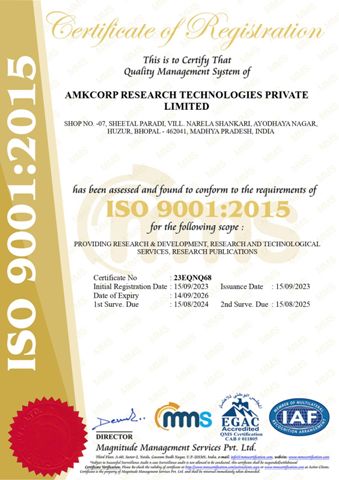

PYTHON POWERED INTELLIGENCE AND ML
AUTHOR(S) - Dr. GAGANDEEP KAUR
DOI – 10.61909/isbn.978-81-966743-6-6.amkedtb102301
Genre/Subject – PYTHON, MACHINE LEARNING, ARTIFICIAL INTELLIGENCE
Scope – MCA 3rd and 4th semester
Book code – AMKEDTB102301 pgs: 496
ISBN(P) – 978-81-966743-7-3
ISBN(E) – 978-81-966743-6-6
Published – 22-10-2023
ABOUT BOOK / ABSTRACT
Python Powered Intelligence And ML is designed to be your essential companion in your journey through the world of Artificial Intelligence and Python programming. We understand the importance of building a solid foundation in AI concepts, as well as mastering the tools and techniques needed to implement AI solutions effectively.
What You’ll Find Inside:
- Foundation of Artificial Intelligence: In Chapter 1, we lay the groundwork for your AI education, providing a strong understanding of the fundamentals.
- Knowledge Presentation: Chapter 2 delves into how knowledge is represented in AI systems, a crucial element for creating intelligent machines.
- Informed / Heuristic Search Strategies: Chapter 3 explores strategies for problem-solving and decision-making, crucial in the AI domain.
- Natural Language Processing: In Chapter 4, we dive into the world of language understanding and processing, a key area of AI.
- Soft Computing: Chapter 5 introduces the concept of soft computing, which enables AI systems to work with uncertainty and imprecision.
- Neural Networks: Chapter 6 covers neural networks, a fundamental technology in modern AI, inspired by the human brain.
- Fuzzy Systems: Chapter 7 is all about fuzzy logic, which allows AI systems to deal with vagueness and uncertainty.
- History of Genetic Algorithms: Chapter 8 takes you through the fascinating history and principles of genetic algorithms.
- Regression: In Chapter 9, we explain regression techniques for predictive modeling, a crucial tool in AI.
- Python Programming: The second part of Python Powered Intelligence And ML focuses on Python, one of the most versatile and popular programming languages.
- Numpy: Chapter 11 introduces the powerful library for numerical computing in Python.
- Pandas: In Chapter 12, we explore Pandas, a tool for data manipulation and analysis.
- Matplotlib: Chapter 13 introduces you to data visualization using Matplotlib.
- Regression: We revisit regression in Chapter 14, providing more insights and applications.
Our aim is to empower you with the knowledge and skills to excel in Artificial Intelligence and Python programming. Whether you are a beginner or an experienced programmer, this book is your go-to resource for AI and Python. We hope you enjoy this journey with us, and may it inspire you to explore the exciting world of Artificial Intelligence and Python programming. Happy learning!
AUTHOR(s)

Dr. GAGANDEEP KAUR
Dr. Gagandeep Kaur is working as an Assistant Professor in the Department of Computer Applications at CT Group of Institutions, Shahpur Campus, Jalandhar. She has 15 years of teaching experience and 2 years of industrial experience. She has a strong academic background, having been awarded the degree of PhD from GNA University Phagwara, holding a Master of Computer Applications (Honours) from Apeejay Institute of Management (Technical Campus). She completed her Bachelor of Computer Applications from Apeejay Institute of Management and Technology Jalandhar and Diploma in French Language from Alliance Francaise Chandigarh.
With a passion for research, Dr. Gagandeep Kaur has published numerous research papers in prestigious national and international journals. She has also presented research papers in various national and international seminars and conferences and has been an observer, examiner, and evaluator for university examinations on several occasions. Her areas of expertise are Machine Learning, Data Communication and Networks, Embedded Systems, Microprocessors, Assembly Language, Database Administration, Data Warehousing, Software Engineering, System Programming, Neural Networks, Soft Computing, Artificial Intelligence, Metaheuristic Algorithms, System Analysis and Design, Linux OS, Object Orientated Analysis and Design and Information Security.
Dr. Gagandeep Kaur’s achievements have been widely lauded throughout her career. Her passion for and dedication to computer science and engineering continue to be the driving forces in her career development.
EDITOR(s) & CONTRIBUTOR(s)

Ms. HARSHITA JAIN
Harshita Jain is an accomplished Assistant Professor in the Department of Computer Science Engineering, with extensive research experience and notable achievements in her field. She has a strong academic background, persuing her phd from UIT RGPV, holding a Master of Technology (MTech) degree in Computer Science and Engineering from Madhav Institute of Science and Technology. She completed her Bachelor of Engineering (BE) in Information Technology from the University Institute of Technology – RGPV.
Harshita has a diverse range of experience in the field of education and research. She served as an Assistant Professor at Laxmi Narain College of Technology (LNCT) and Maulana Azad National Institute of Technology (MANIT) in Bhopal. Additionally, she worked as a Project Manager at YAY, an Edtech company with Girlscript. Currently, she is associated with Sagar Institute of Research & Technology (SIRT) as an Assistant Professor in the Department of Computer Science Engineering.
With a passion for research, Harshita has published numerous research papers in prestigious national and international journals. Her research interests include pattern warehousing, nature-inspired algorithms, therapeutic models, data mining, IoT, and more. She has also contributed as a chapter author in technical books and served as a reviewer for esteemed journals. Furthermore, she has been recognized as an editorial board member for several journals and has delivered expert lectures on machine learning, IoT, and related topics. She has also authored 1 book, hold 3 copyrights and 1 Indian Patent based on IOT.
Harshita’s academic achievements are complemented by her active participation in professional organizations. She is a lifetime member of the International Association of Engineers (IAENG) and Research Foundation of India (RFI). She also holds the position of MP STATE SDG Ambassador for UNaccc and has been recognized as a GDC FieldOps Cadet by the United Nations. She has been listed by Fox story India under ” 50 Powerful women of INDIA” 2022, She has also been the recipient of many awards like Young scientist award, Dynamic professor of the year and many more.
Throughout her career, Harshita Jain has been acknowledged for her outstanding contributions. Her commitment to excellence and dedication to her field continue to drive her professional growth and contribute to the advancement of computer science and engineering.

Mr. PRAKASH MARAVI
Mr. Prakash Maravi,, a Senior Lecturer at Samrat Ashok Technological Institute Polytechnic College in Vidisha, Madhya Pradesh, India, brings a wealth of professional experience spanning over 18+ years, with a significant focus on academia. His roles include teaching undergraduate courses and active involvement in various educational activities. He also serves as the Coordinator of the Institution’s Innovation Council (IIC) Startup, emphasizing his dedication to fostering innovation and entrepreneurship. Mr. Maravi’s academic engagements extend to attending numerous seminars, workshops, faculty development programs (FDPs), and conferences, reflecting his quest for knowledge and research. He is a prolific researcher, with a substantial body of work, including research papers, book chapters, and abstracts presented and published in both national and international conferences and journals. His main research interests encompass the dynamic domains of Data Science, Machine Learning, Natural Language Processing, Artificial Intelligence, Deep Learning, and Big Data. Mr. Prakash Maravi’s dedication and research contributions continue to shape the fields of data science and artificial intelligence, inspiring the academic community and beyond.

Ms. KAMINEE PACHLASIYA
Ms. Kaminee Pachlasiya is an Assistant Professor in the Department of Computer Science & Engineering at Sagar Institute of Research & Technology Excellence (SIRTE) in Bhopal, India. With over five years of experience in teaching and research, she is a dedicated academic professional. Her primary research alignment focuses on critical areas such as cyber security, dark web crime analysis, and investigation techniques, which are increasingly important in the field of computer science and technology. Ms. Pachlasiya actively participates in Seminars, Workshops, and Faculty Development Programs (FDPs), reflecting her commitment to continuous learning and professional growth. Her research interests extend to Machine Learning, Natural Language Processing, Artificial Intelligence, and Image Processing, showcasing a dynamic and inquisitive approach to exploring emerging technologies and knowledge advancement.

Mr. ANANDBABU GOPATOTI
Mr. Anandbabu Gopatoti is a Researcher in the Department of Electronics & Communication Engineering at Hindusthan College of Engineering and Technology, Coimbatore and at Faculty of Information and Communication Engineering, Anna University, Chennai, Tamil Nadu, India. He has completed his Master of Technology in Electronics & Communication Engineering in 2010 from Jawaharlal Nehru Technological University, Kakinada, Andhra Pradesh. He holds his Bachelor Degree in Bachelor of Technology in Electronics & Communication Engineering from Jawaharlal Nehru Technological University, Hyderabad, Telangana. He is the author of more than 27 journal paper publications in national and international journals. He has granted patents in India, United Kingdom, and South Africa. His research interests include Digital Image Processing, Digital Signal Processing, Artificial Intelligence, Satellite Communications and Filters Design.
CHAPTERS
CHAPTER-1: Foundation of Artificial Intelligence
Pages 1-40
CHAPTER-2: Knowledge presentation
Pages 41- 76
CHAPTER-3: Informed / Heuristic search strategies
Pages 77-103
CHAPTER-4: Natural Language processing
Pages 104-122
CHAPTER-5: Soft computing
Pages 123-142
CHAPTER-6: Neural Network
Pages 143-178
CHAPTER-7: Fuzzy Systems
Pages 179-212
CHAPTER-8: History Genetic Algorithms
Pages 213-251
CHAPTER-9: Regression
Pages 252-283
CHAPTER-10: Python Programming
Pages 284-384
CHAPTER-11: Numpy
Pages 385-397
CHAPTER-12: Pandas
Pages 398-420
CHAPTER-13: Matplotlib
Pages 421-439
CHAPTER-14: Regression
Pages 440-474
REFERENCES
[1]. Çelik, Ö. A Research on Machine Learning Methods and Its Applications. Journal of Educational Technology and Online Learning. 2018.
[2]. Sanjay Kumbhare, Dr. S. Saxena, Rohit Rajvaidhya. FEM Based Prediction of Elastic-plastic Fracture Toughness (JSZW) Under Mixed Mode (I/III) Condition. International Research Journal of Engineering & Applied Sciences, IRJEAS, 1(1), pp. 01-09, 2013. https://www.irjeas.org/wp-content/uploads/admin/volume1/V1I1/IRJEAS04_V1I1_01130313_0004.pdf.
[3]. Jin, W. Research on Machine Learning and Its Algorithms and Development. Journal of Physics: Conference Series, 1544(1), 2020. https://doi.org/10.1088/1742-6596/1544/1/012003.
[4]. Neerajkumar Nagayach. A Review on Heat Transfer Augmentation in Circular Tube. International Research Journal of Engineering & Applied Sciences, IRJEAS, 1(1), pp. 16-20, 2013. https://www.irjeas.org/wp-content/uploads/admin/volume1/V1I1/IRJEAS04_V1I1_01130313_0006.pdf.
[5]. Patil, S. J. Python – Using Database and SQL. International Journal of Science and Research (IJSR), 8(2), 83–85, 2019.
https://www.ijsr.net/archive/v8i2/ART20194929.pdf
[6]. Ren, Y. Python Machine Learning : Machine Learning and Deep Learning With Python ,. International Journal of Knowledge-Based Organizations, 11(1), 67–70. 2021.
[7]. Manoj Kumar Jaiswal, Priyanka Jaiswal, Paramjeet Kaur. Voltage Stability improvement with optimum allocation of SVCs using Genetic Algorithm. International Research Journal of Engineering & Applied Sciences, IRJEAS, 1(2), pp. 01-06, 2013. https://www.irjeas.org/wp-content/uploads/admin/volume1/V1I2/IRJEAS04_V1I2_04130613_0003.pdf.
[8]. Raschka, S., Patterson, J., & Nolet, C. Machine learning in python: Main developments and technology trends in data science, machine learning, and artificial intelligence. Information (Switzerland), 11(4), 2020.
https://doi.org/10.3390/info11040193
[9]. Shyam, A., & Mukesh, N. A Django Based Educational Resource Sharing Website: Shreic. Journal of Scientific Research, 64(01), 138–152, 2020.
[10]. Manoj Kumar Jaiswal, Priyanka Jaiswal, Paramjeet Kaur. Voltage Stability improvement with optimum allocation of SVCs using Genetic Algorithm. International Research Journal of Engineering & Applied Sciences, IRJEAS, 1(2), pp. 01-06, 2013. https://www.irjeas.org/wp-content/uploads/admin/volume1/V1I2/IRJEAS04_V1I2_04130613_0003.pdf.
[11]. Taneja, S., & Gupta, P. R. Python as a Tool for Web Server Application Development. International Journal of Information, Communication and Computing Technology, 2(1), 77–83, 2014.
[12]. Ekta Chouhan, Rajesh Kumar Rai. A Novel Approach of Error Correction for Uncompressed HD Frame Over Wireless Network Based on Forward ECT. International Research Journal of Engineering & Applied Sciences, IRJEAS, 1(2), pp. 14-20, 2013. https://www.irjeas.org/wp-content/uploads/admin/volume1/V1I2/IRJEAS04_V1I2_04130613_0004.pdf.
[13]. McCulloch, W.S.; Pitts, W. A logical calculus of the ideas immanent in nervous activity. Bull.Math. Biophys.
[14]. Chandiramani, A. Management of Django Web Development in Python. Journal of Management and Service Science (JMSS), 1(2), 1–17, 2021. https://doi.org/10.54060/jmss/001.02.005
[15]. Arun Kumar. Power Utilization Through Braking System. International Research Journal of Engineering & Applied Sciences, IRJEAS, 1(3), pp. 14-20, 2013.https://www.irjeas.org/wp-content/uploads/admin/volume1/V1I3/IRJEAS04_V1I3_07130913_0004.pdf.
[16]. Eltahawey, A. O. (2017). Database Using Python : A Tutorial. December 2016.
[17]. Gunjal, B., & Koganurmath, M. M. (2014). Database System: Concepts and Design. E-Journals by Research Scholars in National Institute of Technology (NIT) Rourkela, December 1–19. 2003.
[18]. Manoj Kumar Diwaker, Pushpendra Kumar Jain, D.K. Koli. Performance Evaluation and Testing Of CI Engine with Bio-Diesel Blended with Karanja Oil and Waste Vegetable Oil. International Research Journal of Engineering & Applied Sciences, IRJEAS, 1(4), pp. 13-18, 2013. https://www.irjeas.org/wp-content/uploads/admin/volume1/V1I4/IRJEAS04_V1I4_10131213_0004.pdf.
[19]. Gupta, S. B. B. E. P. A., & Madnick, S. E., A FRAMEWORK AND COMPARATIVE STUDY OF DISTRIBUTED HETEROGENEOUS DATABASE MANAGEMENT SYSTEMS. Working paper, 1988.
[20]. Jin, W. Research on Machine Learning and Its Algorithms and Development. Journal of Physics: Conference Series, 1544(1), 2020. https://doi.org/10.1088/1742-6596/1544/1/012003
[21]. Ankit Gaur, Prabhash Jain. Static Analysis of Leaf Spring Made of Composite Material. International Research Journal of Engineering & Applied Sciences, IRJEAS, 1(4), pp. 24-29, 2013. https://www.irjeas.org/wp-content/uploads/admin/volume1/V1I4/IRJEAS04_V1I4_10131213_0005.pdf.
[22]. Anurag Shrivastava. Dynamic Data Mining – A Survey to New Approach. International Research Journal of Engineering & Applied Sciences, IRJEAS, 1(4), pp. 43-49, 2013. https://www.irjeas.org/wp-content/uploads/admin/volume1/V1I4/IRJEAS04_V1I4_10131213_0008.pdf.
[23]. Kossmann, J., & Schlosser, R. (2019). A framework for selfmanaging database systems. Proceedings – 2019 IEEE 35th International Conference on Data Engineering Workshops, ICDE, 100–106, 2019. https://doi.org/10.1109/ICDEW.2019.00-27
[24]. Jason Lee, Elman Mansimov, and Kyunghyun Cho.2018. Deterministic non-autoregressive neural sequence modeling by iterative refinement.
[25]. Manvendra Singh Thakur, Savita Vyas, Anurag Gour. Rolling Towards Renewability by Studying Photovoltaic Solar Cells and the Comparison of their Performance under Enhanced Illumination. International Research Journal of Engineering & Applied Sciences, IRJEAS, 2(1), pp. 10-15, 2014. https://www.irjeas.org/wp-content/uploads/admin/volume2/V2I1/V2I1_01140314_0004.pdf.
[26]. LangChain. 2023. Hwchase17/langchain: building applications with llms through omposability.
Quoc V. Le and Tomas Mikolov. 2014. Distributed.
[27]. Taneja, S., & Gupta, P. R. Python as a Tool for Web Server Application Development. International Journal of Information, Communication and Computing Technology, 2(1), 77–83, 2014. https://www.jimsindia.org/8i_Journal/VolumeII/Python-as-atool-for-web-server-application-development.pdf.
[28]. Deeksha Choudhary, Dr. Deepika Masand. MATLAB Graphical User Interface based Analysis of Various Parameters of Self Excited Induction Generator. International Research Journal of Engineering & Applied Sciences, IRJEAS, 2(1), pp. 27-33, 2014. https://www.irjeas.org/wp-content/uploads/admin/volume2/V2I1/V2I1_01140314_0002.pdf.
[29]. Suraya, S., & Sholeh, M. Designing and Implementing a Database for Thesis Data Management by Using the Python Flask Framework. International Journal of Engineering, Science and Information Technology, 2(1), 9–14, 2021. https://doi.org/10.52088/ijesty.v2i1.197.
[30]. Diksha Rani Singh, Sourabh Gupta. Simulink Model of Shunt Active Power Filter Using Instantaneous Power Theory. International Research Journal of Engineering & Applied Sciences, IRJEAS, 2(2), pp. 12-15, 2014. https://www.irjeas.org/wp-content/uploads/admin/volume2/V2I2/V2I2_04140614_0003.pdf.
[31]. Priya Ahirwar et.al. “Fake News Detection Using Machine learning Technique : A Review.” International Research Journal of Engineering & Applied Sciences (IRJEAS). 11(4), pp. 01-07, 2023. https://doi.org/10.55083/irjeas.2023.v11i04001.
[32]. Swasti Goyal, Tanya Sharma, Anuj Kumar. A Review on Breast Cancer Prediction Using Machine Learning. International Research Journal of Engineering & Applied Sciences (IRJEAS). 10(4), pp. 01-07, 2022. https://doi.org/10.55083/irjeas.2022.v10i04001.
[33]. Abhishek Dixit, Santosh Kumar. Machine Learning Based Efficient Protection Scheme for AC Microgrid. International Research Journal of Engineering & Applied Sciences (IRJEAS). 10(4), pp. 18-23, 2022. https://doi.org/10.55083/irjeas.2022.v10i04009.
[34]. Nisheet Tiwari, Chandramani Mishra, S.P.S. Rajput. Estimation of liquefaction potential of soil using NeuroFuzzy Techniques. International Research Journal of Engineering & Applied Sciences, IRJEAS, 2(2), pp. 01-11, 2014. https://www.irjeas.org/wp-content/uploads/admin/volume2/V2I2/V2I2_04140614_0001.pdf.
[35]. Satish Kumar Yadav, Santosh Kumar. Fault Diagosis of CHB Inverter Using Machine Learning. International Research Journal of Engineering & Applied Sciences (IRJEAS). 10(4), pp. 24-29, 2022. https://doi.org/10.55083/irjeas.2022.v10i04007.
[36]. Deepa Singh, Laxman Solankee. MACHINE LEARNING BASED FAULT DIAGNOSIS SCHEME FOR GRID-CONNECTED PV SYSTEM. International Research Journal of Engineering & Applied Sciences, (IRJEAS), 9(4), pp. 28-33, 2021. https://doi.org/10.55083/irjeas.2021.v09i04007.
[37]. Swarnim Tiwari, Kamlesh Dubey. CFD SIMULATION OF HEAT TRANSFER THROUGH A ABSORBER PLATE OF SOLAR AIR HEATER WITH ARTIFICIAL ROUGHNESS. International Research Journal of Engineering & Applied Sciences, (IRJEAS). 9(1), pp. 15-19, 2021. https://doi.org/10.55083/irjeas.2021.v09i01004.
[38]. Yasir Afzal, Vandana Jha, Anil Mohapatra. A Comparative Study Based on ANSYS Analysis of Existing Sprocket’s Material with High Performance Engineering Plastic Materials. International Research Journal of Engineering & Applied Sciences, IRJEAS, 2(3), pp. 01-07, 2014. https://www.irjeas.org/wp-content/uploads/admin/volume2/V2I3/V2I3_07140914_0007.pdf.
[39]. Syed Zamil Hasan Shoumo et al., “Application of Machine Learning in Credit Threat Assessment: A Prelude to Smart Banking” 2019 IEEE Region 10 Conference (TENCON 2019), 6/19/2019 IEEE, ISSN 978-1-7281- 1895, 2022- 2028.
[40]. Arun Bhuneriya, Dr. Rohit Rajvaidya, P.K. Pandey. Development of Composition of Composite Material Used For Automotive Brake Liner (An Experimental Approach). International Research Journal of Engineering & Applied Sciences, IRJEAS, 2(3), pp. 08-13, 2014. https://www.irjeas.org/wp-content/uploads/admin/volume2/V2I3/V2I3_07140914_0002.pdf.
[41]. Dianning Wu et al., “Analysis and Evaluation of Settlement Threat in Power Market based on Triangular Fuzzy Number”2019 International Conference on Artificial Intelligence and Advanced Manufacturing (AIAM), 978-1- 7281-4691-1/19, 13-17.
[42]. Ravikant Khatik, Dr. Rohit Rajvaidya, Dr. Ajay Nema. Optimization of Thermal Behavior and Mechanical Properties of Green Shade Nets at Constant Temperature. International Research Journal of Engineering & Applied Sciences, IRJEAS, 2(3), pp. 27-32, 2014. https://www.irjeas.org/wp-content/uploads/admin/volume2/V2I3/V2I3_07140914_0005.pdf.
[43]. Loris Nanni , Alessandra Lumini, “An experimental comparison of ensemble of classifiers for bankruptcy prediction and credit scoring”, Elsevier, Expert Systems with Applications 36 (2009) 3028–3033.
[44]. Brijesh Sharma, Amol Barve, Rohit Kumar Gupta. Multiphase converter with output impedance correction circuit (OICC) based on Peak current mode control(PCMC). International Research Journal of Engineering & Applied Sciences, IRJEAS, 2(3), pp. 61-66, 2014. https://www.irjeas.org/wp-content/uploads/admin/volume2/V2I3/V2I3_07140914_0016.pdf.
[45]. Usama Fayyad, Gregory Piatetsky-Shapiro, and Padhraic Smyth, “From Data Mining to Knowledge Discovery in Databases”,American Association for Artificial Intelligence. All rights reserved. 0738-4602-1996.
[46]. A.S. Chandel, Prabhash Jain, Dr. Anil Kumar. Case Study on Cold Air Distribution of a Data Centre. International Research Journal of Engineering & Applied Sciences, IRJEAS, 2(4), pp. 01-05, 2014. https://www.irjeas.org/wp-content/uploads/admin/volume2/V2I4/V2I4_10141214_0002.pdf.
[47]. K. Tumer and N. C. Oza, “Decimated input ensembles for improved generalization,” in Proceedings of the International Joint Conference on Neural Networks (IJCNN ’99), pp. 3069– 3074, Washington, DC, USA, July 1999.
[48]. European Central Bank, “Third report on card fraud,” European Central Bank, Tech. Rep., 2014.





